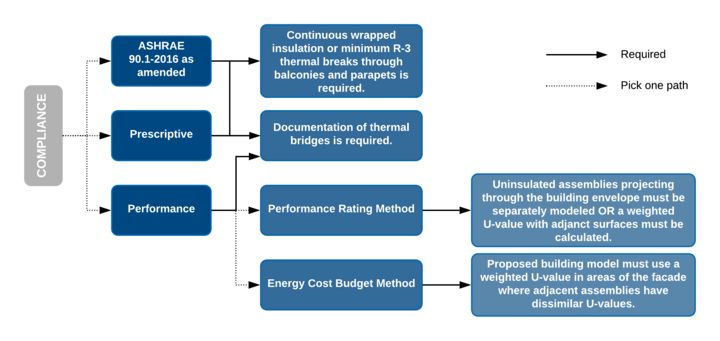North America Building Energy Codes.
Paths to compliance.
Throughout North America, building energy codes have introduced requirements to address thermal bridges that occur at penetrations in the building envelope. These code advancements were initiated as a response to findings that annual building energy use increases as a result of unmitigated heat flow through the cumulative impact of thermal bridges.
Please read on for the relevant codes in the United States and Canada.
UNITED STATES
New York City Energy Conservation Code (NYCECC)
In the New York City Energy Conservation Code, each of the three compliance pathways has requirements for addressing thermal bridging.
Both the ASHRAE 90.1-2016 (as amended) and the Prescriptive pathways require either continuous wrapped insulation or a minimum R-3 thermal break through balconies and parapets. (NOTE: The assembly R-value of a thermal break is dependent on the structural capacity and type of thermal break installed. To determine the R-values for a specific Schöck structural thermal break product, please contact us.)
For buildings pursuing the Performance path, two methodologies are offered for evaluating the performance of the proposed design: the Performance Rating Method and the Energy Cost Budget Method. When following the Performance Rating Method, thermal bridges must either be separately modeled or accounted for using a weighted U-value with adjacent surfaces. When following the Energy Cost Budget Method, thermal bridges are accounted for using only a weighted U-value with adjacent surfaces.
One requirement that is characteristic of all three compliance pathways is the need to submit documentation of clear field, point and linear thermal bridges.
For more detailed information and guidance about the NYCECC’s requirements for addressing and documenting thermal bridges, visit pages 11 and 16 of this How-to-Guide from NYC Buildings
New York Stretch Energy Code (NYStretch)
Developed by the New York State Energy Research and Development Authority (NYSERDA), the New York Stretch Energy Code 2020 (NYStretch 2020) is a statewide model code for New York jurisdictions to use to meet their energy and climate goals by accelerating the savings obtained through their local building energy codes. As the name infers, NYStretch proposes measures that stretch beyond baseline code with the incentive of achieving roughly 11% in additional energy savings over New York State’s baseline energy code.
Adoption of the NYStretch 2020 Energy Code is optional.
Regarding balcony or parapet thermal bridges, the Prescriptive compliance path of NYStretch requires either continuous wrapped insulation around the structural element or a minimum R-3 thermal break where the building envelope is penetrated.
Visit NYSERDA’s website for toolkits, fact sheets, and supporting documentation for adopting NYStretch.
Seattle Energy Code
The Seattle Energy Code singles out linear thermal bridges via concrete slabs that penetrate the building envelope, including but not limited to decks and balconies. As is common with most codes in North America, three pathways to compliance are offered; however, the specific paths vary slightly from other codes discussed above:
- Option 1 – Prescriptive Path:
Concrete slabs that penetrate the building thermal envelope shall each include a minimum R-10 thermal break, with allowance for stainless steel (NOT carbon steel) reinforcing bars to penetrate the thermal break. - Option 2 – Total Building Performance Method:
This path requires whole building energy modeling via compliance with ASHRAE 90.1 Appendix G. In the energy model, concrete thermal bridges must be accounted for by using a default U-factor for exposed concrete (see table A103.3.7.2 below). - Option 3 – Target Performance Method:
This path has the same requirements regarding concrete thermal bridges as Option 2. Other aspects of this method are more relaxed in comparison to Option 2, but there is a caveat that the actual measured energy consumption of the building performs as good or better than the design target. Those pursuing this path are required to provide a financial security deposit to be used as a penalty for failing to achieve the intended energy use target.
Visit the City of Seattle’s website to access the full energy code.
Addendum av to ASHRAE 90.1-2019 [Has not yet been published]
The proposed addendum to ASHRAE 90.1-2019 will improve the energy efficiency of buildings by addressing thermal bridges not currently regulated by the Standard. Types of thermal bridges primarily include thermal bridges in mass walls from framing, floor assembly projections (balconies and overhangs), roof parapets and point thermal bridges exceeding an allowable cross section area.
As of the time of writing this, Addendum av to ASHRAE 90.1-2019 has been through two comment periods and has not yet been published.
In the 2nd draft of Addendum av, modifications and additions to Section 5 for Prescriptive Compliance, Chapter 11 for the Energy Cost Budget Method, and Appendix G for the Performance Rating Method are proposed.
Source: Proposed Addendum av to Standard 90.1-2019, Energy Standard for Buildings Except Low-Rise Residential Buildings – Second Public Review, March 2020
Schöck is monitoring progress of Addendum av to ASHRAE 90.1-2019 and will update this page as changes occur.
CANADA
Quebec Energy Code
Per the Quebec Energy Code for Buildings, “where they penetrate the envelope, interior walls, foundation walls, firewalls, party walls, structural members such as slabs, ornamentations and other appendages are an important source of heat losses and have a significant impact on the overall thermal performance of the building envelope.” Based on this reasoning, Quebec’s code has been updated as of March 2021 to take a more aggressive approach to addressing thermal bridging.
To comply with the Quebec Energy Code, three paths are offered: the Prescriptive (Section 3.2), Trade-off (Section 3.3), and Performance paths (Part 8).
If pursuing the Prescriptive Path, Section 3.2.1.2 offers options for addressing thermal bridges to maintain continuous insulation of the building envelope. See the criteria below from Section 3.2.1.2.
Further guidance on acceptable methods for maintaining continuous insulation is provided in the Notes to Part 3 Building Envelope. Included in the Notes, Figure A-3.2.1.2(4)-B suggests incorporating a structural thermal break to meet the code requirements. Check out this LinkedIn post for a comparison of thermal performance of the methods included in the Notes section.
If pursuing compliance via the Trade-Off Path, the sum of the areas of all above-ground building assemblies of the proposed building divided by their effective thermal resistances shall not be more than it would be if pursuing compliance via the Prescriptive path. The effect of thermal bridging on opaque wall assemblies is considered by calculating the derated effective thermal resistance of the assembly or by using a default thermal transmittance value provided by the code.
If pursuing compliance via the Performance Path, the annual energy usage of the proposed building must not exceed that of the baseline building. Like the Trade-Off Path, the impact of thermal bridging is captured by calculating a derated effective thermal resistance.
Toronto and British Columbia Codes
The building codes of both Toronto and British Columbia set forth an entirely performance-based energy requirement for new construction projects. No prescriptive compliance path is offered.
While there are no specific requirements for incorporating structural thermal breaks, meeting the building performance targets is more easily achieved by reducing or eliminating thermal bridges.
For comments or questions regarding code compliance of Schöck’s products, please contact us.







